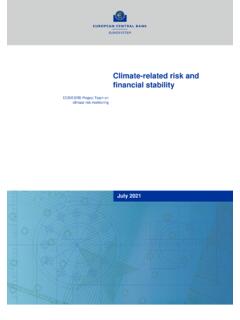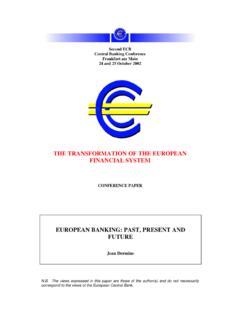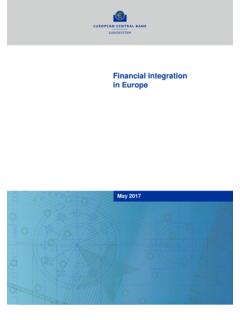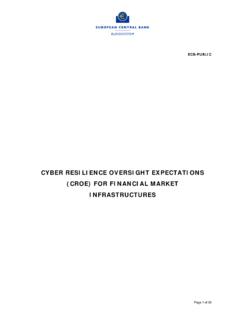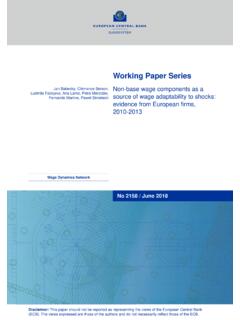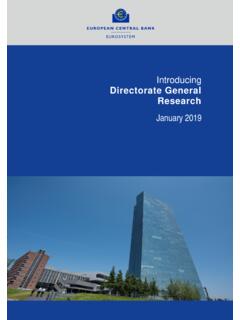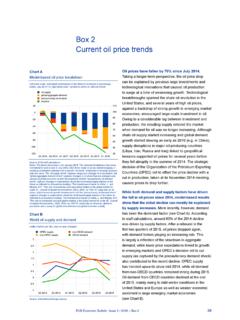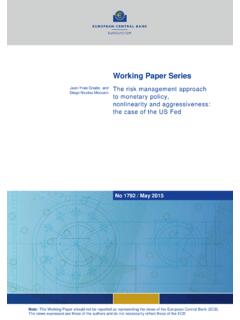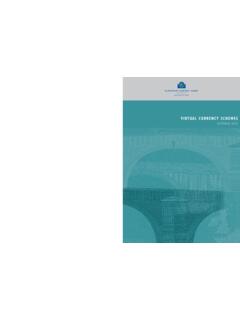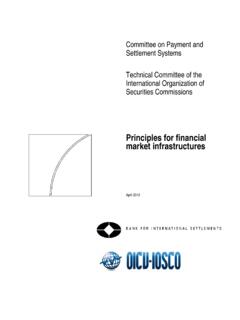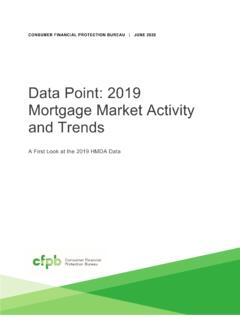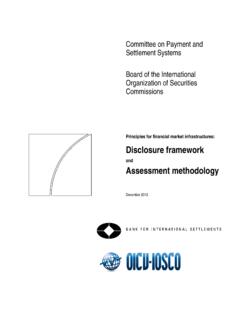Transcription of Cyber resilience oversight expectations for financial ...
1 Cyber resilience oversight expectations for financial market infrastructures December 2018 Cyber resilience oversight expectations for financial market infrastructures Contents 1 Contents 1 Introduction 2 Background 2 Purpose 3 Addressees 4 expectations by type of FMI 4 Structure of the document 7 2 Cyber resilience oversight expectations 9 Governance 9 Identification 18 Protection 20 Detection 31 Response and recovery 33 Testing 41 Situational awareness 46 Learning and evolving 50 3 Annexes 53 Glossary 53 Abbreviations 59 Guidance on the Senior Executive 61 Cyber resilience oversight expectations for financial market infrastructures Introduction 2 1 Introduction Background The safe and efficient operation of financial market infrastructures (FMIs) is essential for maintaining and promoting financial stability and economic growth.
2 If not properly managed, FMIs can become sources of financial shocks, such as liquidity dislocations and credit losses, or major channels through which these shocks are transmitted across domestic and international financial markets. In this context, the level of Cyber resilience , which contributes to an FMI s operational resilience , can be a decisive factor in the overall resilience of the financial system and the broader economy. In June 2016, the Committee on Payments and market Infrastructures (CPMI) and the International Organization of Securities Commissions (IOSCO) published the Guidance on Cyber resilience for financial market infrastructures (Guidance)1, which requires FMIs to immediately take the necessary steps to implement it, together with relevant stakeholders, to ensure that they enhance their levels of Cyber resilience . The Guidance has been developed to supplement the Principles for financial market infrastructures (PFMIs)2, which the Committee on Payment and Settlement Systems (CPSS) and IOSCO published in April 2012, and the ECB s Governing Council adopted on 3 June 2013 for the conduct of Eurosystem oversight in relation to all types of FMIs.
3 Cyber risks should be managed as part of FMIs overall operational risk management framework. However, some unique characteristics of Cyber risk present challenges to FMIs traditional operational risk management frameworks, as noted in the Guidance: First, a distinguishing characteristic of Cyber attacks is often the persistent nature of a campaign conducted by a motivated attacker ( advanced persistent threat attacks). The presence of an active, persistent and sometimes sophisticated adversary in Cyber attacks means that, unlike most other sources of risk, Cyber attacks are often difficult to identify or fully eradicate and the breadth of impact can be difficult to determine. Second, there is a broad range of entry points through which an FMI could be compromised. As a result of their interconnectedness, Cyber attacks could arise through FMIs participants, linked FMIs, service providers, vendors or vendor products.
4 FMIs could themselves become a channel to further propagate Cyber attacks, for example, via the distribution of malware to interconnected entities. Unlike physical operational disruptions, Cyber risk posed by an interconnected entity is not necessarily related to the degree of that entity s relevance to the FMI s business. From a Cyber perspective, a small-value/volume participant or a vendor providing non-critical services may be as risky as a major participant or a critical service provider. Internally, the risk of an insider threat from rogue or careless employees opens up yet another avenue for possible compromises. 1 See CPMI-IOSCO (June 2016), Guidance on Cyber resilience for financial market infrastructures . 2 See CPSS-IOSCO (April 2012), Principles for financial market infrastructures.
5 Cyber resilience oversight expectations for financial market infrastructures Introduction 3 Third, certain Cyber attacks can render some risk management and business continuity arrangements ineffective. For example, automated system and data replication arrangements that are designed to help preserve sensitive data and software in the event of a physical disruptive event might, in some instances, fuel the propagation of malware and corrupted data to backup systems. Overall, a Cyber attack s potential to cause significant service disruption to the broader financial system determines the urgency of needing to have an effective approach in place to manage it, and to minimise the probability that resuming service will introduce additional risks to an FMI or the wider financial sector. Fourth, Cyber attacks can be stealthy and propagate rapidly within a network of systems.
6 For example, they can exploit unknown vulnerabilities and weak links in systems and protocols to cause disruption and/or infiltrate an FMI s internal network. Malware designed to take advantage of such latent vulnerabilities may circumvent controls. To minimise the impact of such attacks, FMIs require capabilities to swiftly detect, respond to, contain and recover from them. Therefore, FMIs should continuously work to enhance their Cyber resilience capabilities with the objective of limiting the escalating risks that Cyber threats pose both to FMIs themselves and to their overall ecosystems. Purpose The Guidance applies to FMIs since its publication in June 2016. Overseers must simultaneously develop an oversight approach to assess their FMIs against the Guidance. In this context, the Cyber resilience oversight expectations (CROE) serves the following three key purposes: (i) it provides FMIs with detailed steps on how to operationalise the Guidance, ensuring they are able to foster improvements and enhance their Cyber resilience over a sustained period of time; (ii) it provides overseers with clear expectations to assess the FMIs for which they are responsible; and (iii) it provides the basis for a meaningful discussion between the FMIs and their respective overseers.
7 The CROE is based on the Guidance and utilises the existing PFMIs to ensure a full and coherent set of expectations . Additionally, while developing the CROE, the Eurosystem oversight function also considered existing international guidance documents and frameworks; t he NIST Cybersecurity Framework, ISO/IEC 27002, COBIT 5, the Information Security Forum s Standard of Good Practice for Information Security and the Federal financial Institutions Examination Council s (FFIEC) Cybersecurity Assessment Tool were used as a basis, in particular. Although FMIs may use maturity models from other international standards and frameworks for their internal purposes, the levels of expectation set out in the CROE provide the benchmark for overseers to determine their FMIs Cyber resilience capabilities against the Guidance. Cyber resilience oversight expectations for financial market infrastructures Introduction 4 Addressees In addition to the PFMIs and the Guidance, the ECB s Governing Council has also adopted the CROE and will be applied by the Eurosystem for the oversight of all payment systems3 and T2S.
8 Although the oversight of payment systems and of T2S is a Eurosystem competence, the oversight of clearing and settlement systems (securities settlement systems (SSSs) or central securities depositories (CSDs) and central counterparties (CCPs)) in most countries of the euro area is conducted by national central banks under national law competencies, often in cooperation with other national authorities. Therefore, national central banks and these other authorities may also opt to use the CROE for these FMIs, in line with the applicable laws and regulations, to achieve the intended results. The expectations are without prejudice to the application of all relevant laws and regulations. Although the CROE is directly aimed at FMIs, it is important for FMIs to take an active role in communicating with their participants and other relevant stakeholders to promote understanding and support of Cyber resilience objectives and their implementation.
9 Given the extensive interconnections in the financial system, an FMI s Cyber resilience is in part dependent on that of interconnected FMIs, service providers and participants. expectations by type of FMI Levels of expectation The Cyber threat landscape is constantly evolving and reaching higher levels of sophistication. In the light of this, FMIs should make further efforts to adapt, evolve and improve their Cyber resilience capabilities. To address the idea of continuous adaptation, evolution and improvement, the CROE sets out levels of expectation which provide the overseers and FMIs with a benchmark against which they can evaluate the FMIs current level of Cyber resilience , measure progression and establish priority areas for improvement. The CROE establishes three levels of expectation: evolving, advancing and innovating. 3 These include systemically important payment systems (SIPS), prominently important retail payment systems (PIRPS) and other retail payment systems (ORPS).
10 Cyber resilience oversight expectations for financial market infrastructures Introduction 5 The continuous improvement and maturing on the part of the FMI is the essence of these three levels of expectation. Indeed, the levels of expectations are not designed to establish static requirements and an end state of Cyber resilience , which risks creating a culture of compliance. Rather, FMIs are expected to be constantly evolving, advancing and innovating in the light of the continuously evolving Cyber threat landscape. The three levels of expectation are defined below. Evolving: Essential capabilities are established, evolve and are sustained across the FMI to identify, manage and mitigate Cyber risks, in alignment with the Cyber resilience strategy and framework approved by the Board. P erformance of practices is monitored and managed. Advancing: In addition to meeting the evolving level s requirements, practices at this level involve implementing more advanced tools ( advanced technology and risk management tools) that are integrated across the FMI s business lines and have been improved over time to proactively manage Cyber risks posed to the FMI.
